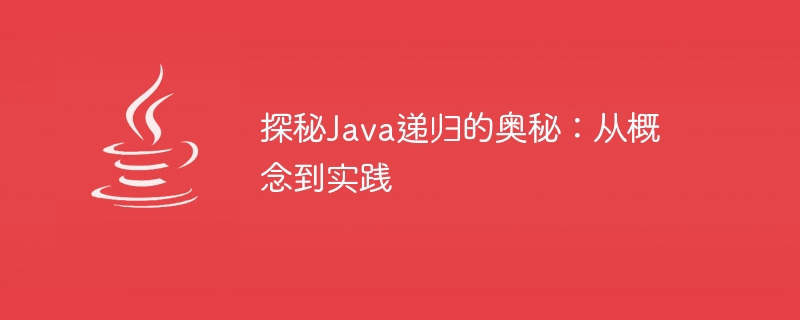Home >Java >javaTutorial >Uncovering the secrets of Java recursion: from theory to application
Uncovering the secrets of Java recursion: from theory to application
- WBOYWBOYWBOYWBOYWBOYWBOYWBOYWBOYWBOYWBOYWBOYWBOYWBOriginal
- 2024-01-30 10:07:061352browse

Exploring the secrets of Java recursion: from concept to practice
Introduction:
Recursion is an important programming technique in computer science, used in many algorithms and data It has a wide range of applications in structures. As a popular programming language, Java also provides a powerful recursive mechanism. This article will take you to explore the mysteries of Java recursion by analyzing the concepts, principles and practical applications of recursion.
1. The concept and principle of recursion
1.1 Definition of recursion
Recursion refers to breaking the problem into smaller sub-problems with the same structure when solving the problem, and solving it by calling itself process of these sub-problems. Simply put, recursion solves a problem by calling itself over and over again.
1.2 Recursion principle
The implementation principle of recursion can be summarized as the following points:
- Baseline condition (Base Case): the stopping condition of recursion. When the baseline condition is met, the recursion will not continue.
- Recursive condition (Recursive Case): The condition that triggers the continuation of recursion. By calling itself and constantly changing parameters, the problem size is gradually reduced.
2. Practical applications of recursion
2.1 Factorial function
The factorial function is one of the most common applications of recursion. The following is a sample code for calculating factorial:
public class Factorial {
public static int factorial(int n) {
// 基线条件:0的阶乘为1
if (n == 0) {
return 1;
}
// 递归条件:调用自身,问题规模缩小
return n * factorial(n - 1);
}
public static void main(String[] args) {
int result = factorial(5);
System.out.println("5的阶乘结果为:" + result);
}
}In this example, the factorial function gradually reduces the size of the problem by continuously calling itself and changing the value of the parameter n.
2.2 Fibonacci Sequence
Fibonacci Sequence is another classic recursive application. The following is a sample code for calculating Fibonacci numbers:
public class Fibonacci {
public static int fibonacci(int n) {
// 基线条件:当n等于0或1时,斐波那契数为n
if (n == 0 || n == 1) {
return n;
}
// 递归条件:调用自身,问题规模缩小
return fibonacci(n - 1) + fibonacci(n - 2);
}
public static void main(String[] args) {
int result = fibonacci(6);
System.out.println("第六个斐波那契数为:" + result);
}
}In this example, the calculation of Fibonacci numbers is also implemented recursively. Recursive calls continuously decompose the problem into smaller sub-problems, and then combine the solutions of the sub-problems to obtain the final result.
3. Advantages and Disadvantages of Recursion
3.1 Advantages
- Simple and clear: Recursion can break down complex problems into simple sub-problems, making the code logic clearer and more concise.
- Reuse: Recursive calls can reuse their own code, improving the reusability of the code.
3.2 Disadvantages
- High overhead: recursive calls will occupy more memory and stack space, resulting in poor performance.
- Easy to cause stack overflow: Recursion may be called in an infinite loop. When the scale of the problem is very large, it may cause a stack overflow error.
Conclusion:
Recursion is a powerful programming technique that can solve many complex problems. However, in practical applications, we need to use recursion carefully, consider its advantages and disadvantages, and avoid performance problems. I hope that through the discussion in this article, readers can have a deeper understanding of the mysteries of Java recursion and be able to apply it skillfully in practice.
The above is the detailed content of Uncovering the secrets of Java recursion: from theory to application. For more information, please follow other related articles on the PHP Chinese website!
Related articles
See more- Teach you step by step how to use Node.js for TCP network communication (Practice)
- How to develop small programs using Taro + Vue3? (practice)
- The most systematic mastery of real-time extraction of Oracle data from the Flink CDC series (mining and tuning practices)
- What is the concept of software architecture
- Tips and best practices for drag-and-drop selection and placement in Vue

